In Laos, we are familiar with Guava trees (ton mak sida) that grow easily in gardens, on roadsides, in fields and whose fruits are commonly sold in markets. But what is called Strawberry Guava the is much rarer.
Like the Guava tree, Psidium guajava, the Strawberry Guava, Psidium cattleianum is a shrub or small tree with smooth brown bark. Its leaves are very different from those of the Guava tree, they are oval, smooth, thick, dark green, with barely visible veins. The flowers resemble those of the ton mak sida, they are white with a tuft of yellow stamens in the center. The fruit also immediately evokes the Guava, it is however smaller, still marked by the calyx scar but it is especially its purplish red color when ripe that makes the difference; its skin is smooth, shiny and cracks under the tooth. It contains a white pulp that envelops a few yellow seeds. This Strawberry Guava, unlike the Guava, can be eaten whole; it is juicy, refreshing, slightly acidic and the few seeds are not bothersome to swallow; its taste is sometimes described as that of wild Strawberry, sometimes as that of Passion fruit with an additional note of Rose petal!
We then understand the names that have been given to it in reference to other fruits from temperate countries. The genus Psidium is native to Latin America and more particularly to Brazil for P. cattleianum. The scientific name “psidium” comes from the Greek “psidion” which names the Pomegranate (mak phila) and the attribute “cattleianum” honors the English horticulturist William Cattley.
For its fruit, which is used to make juices, jams and wines, the Strawberry Guava tree has been introduced and has become naturalised in many tropical areas, particularly the Indian Ocean, Sri Lanka, Reunion Island and the Pacific Islands. Thailand and Vietnam have also undertaken planting trials. However, these introductions are not without risk, particularly in islands with fragile ecosystems. The Strawberry Guava tree, which is even more hardy than the Guava tree, reproduces quickly and well; it quickly forms dense thickets that gradually exclude the original vegetation. It is considered one of the most invasive species in several islands of the Indian Ocean (Mauritius and Reunion Island), Australia and Hawaii.
On connaît bien au Laos les goyaviers (ton mak sida) qui poussent facilement dans les jardins, sur les bords de route, dans les champs et dont les fruits sont couramment vendus sur les marchés. Mais ce que l’on nomme, à tort, la goyave de Chine est beaucoup plus rare.
Comme le goyavier, Psidium guajava, le goyavier de Chine, Psidium cattleianum est un arbuste ou un petit arbre à l’écorce brune et lisse. Ses feuilles sont très différentes de celles du goyavier, elles sont ovales, lisses, épaisses, vert sombre, avec des nervures à peine visibles. Les fleurs ressemblent à celles de ton mak sida, elles sont blanches avec au centre une houppette d’étamines jaunes. Le fruit lui aussi évoque tout de suite la goyave, il est cependant plus petit, toujours marqué par la cicatrice du calice mais c’est surtout sa couleur rouge violacé à maturité qui fait la différence; sa peau est lisse, brillante et craque sous la dent. Il contient une pulpe blanche qui enveloppe quelques graines jaunes. Cette goyave–fraise, à la différence de la goyave, peut être croquée toute entière; elle est juteuse, rafraîchissante, légèrement acidulée et les quelques graines ne sont pas gênantes à avaler; son goût est décrit tantôt comme celui de la fraise des bois, tantôt comme celui du fruit de la passion avec en outre une note de pétale de rose !
On comprend alors les noms qui lui ont été donnés en référence à d’autres fruits de pays tempérés. En revanche l’appellation goyave de Chine est impropre puisque le genre Psidium est originaire d’Amérique latine et plus particulièrement du Brésil pour P. cattleianum. Le nom scientifique « psidium » vient du grec « psidion » qui nomme la grenade (mak phila) et l’attribut « cattleianum » honore l’horticulteur anglais William Cattley.
Pour son fruit avec lequel on fait des jus, des confitures et des vins, le goyavier de Chine a été introduit et s’est naturalisé dans de nombreuses zones tropicales en particulier l’Océan indien, le Sri Lanka, la Réunion, les îles du Pacifique. La Thaïlande et le Vietnam ont entrepris eux aussi des essais de plantation. Mais ces introductions ne sont pas sans risque, en particulier dans les îles à l’écosystème fragile. Le goyavier de Chine plus rustique encore que le goyavier se reproduit vite et bien; il forme rapidement des fourrés denses qui excluent peu à peu la végétation d’origine. Il est considéré comme l’une des espèces les plus invasives dans plusieurs îles de l’Océan Indien (Maurice et la Réunion), en Australie et à Hawaï.
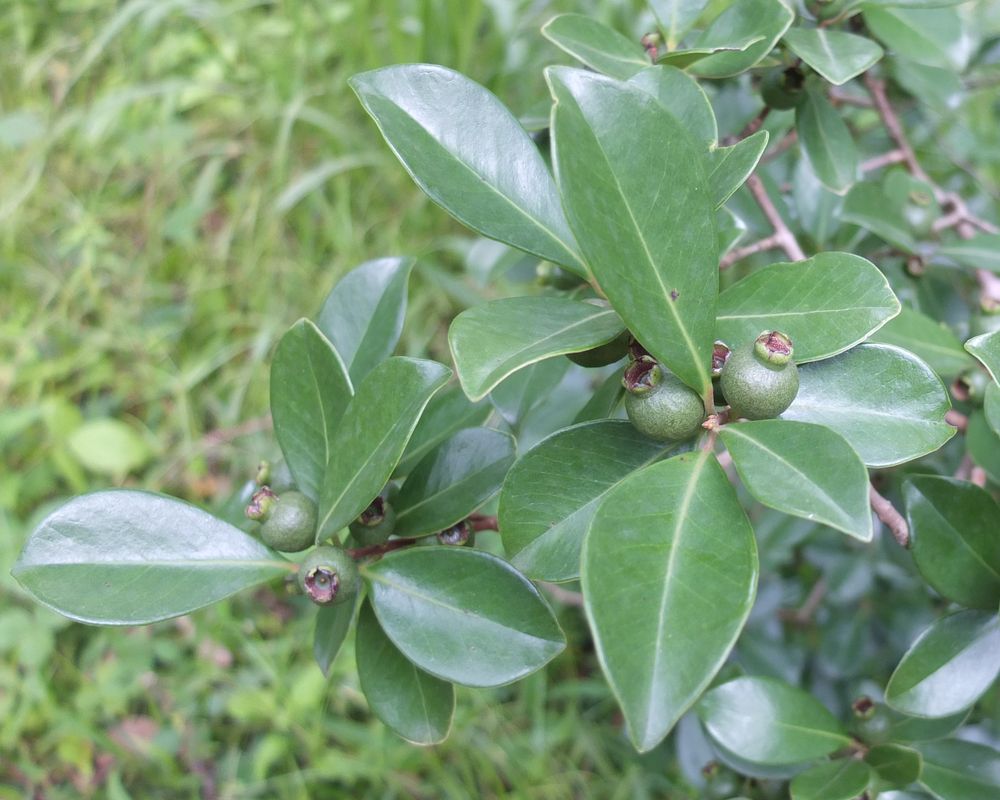
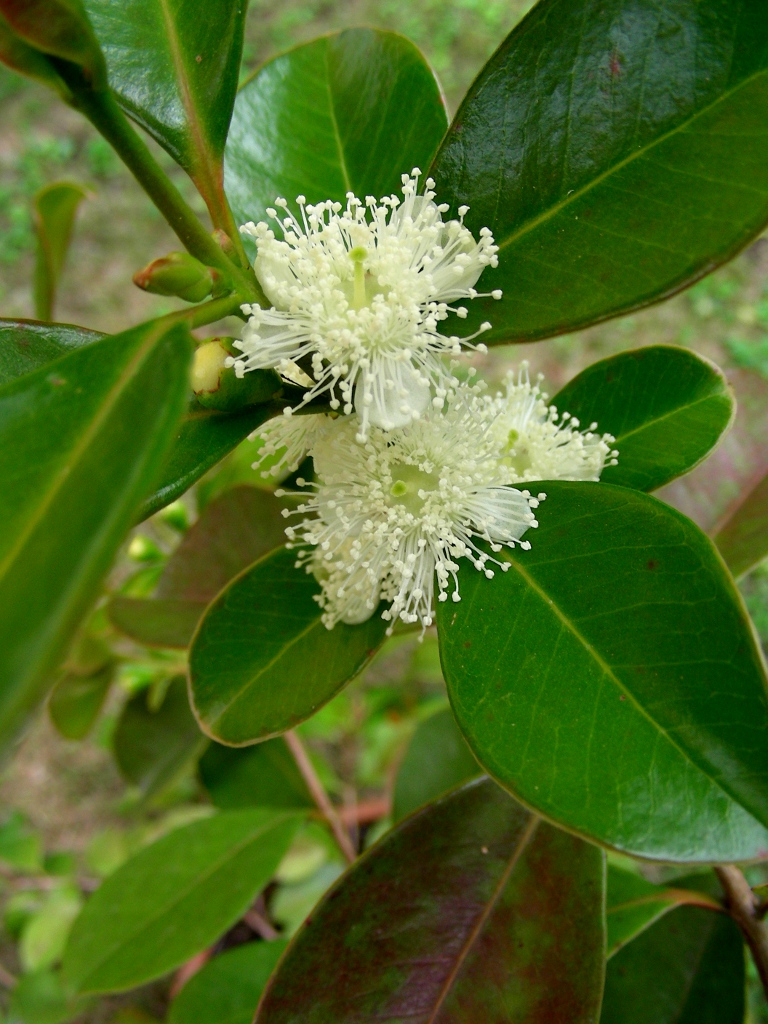
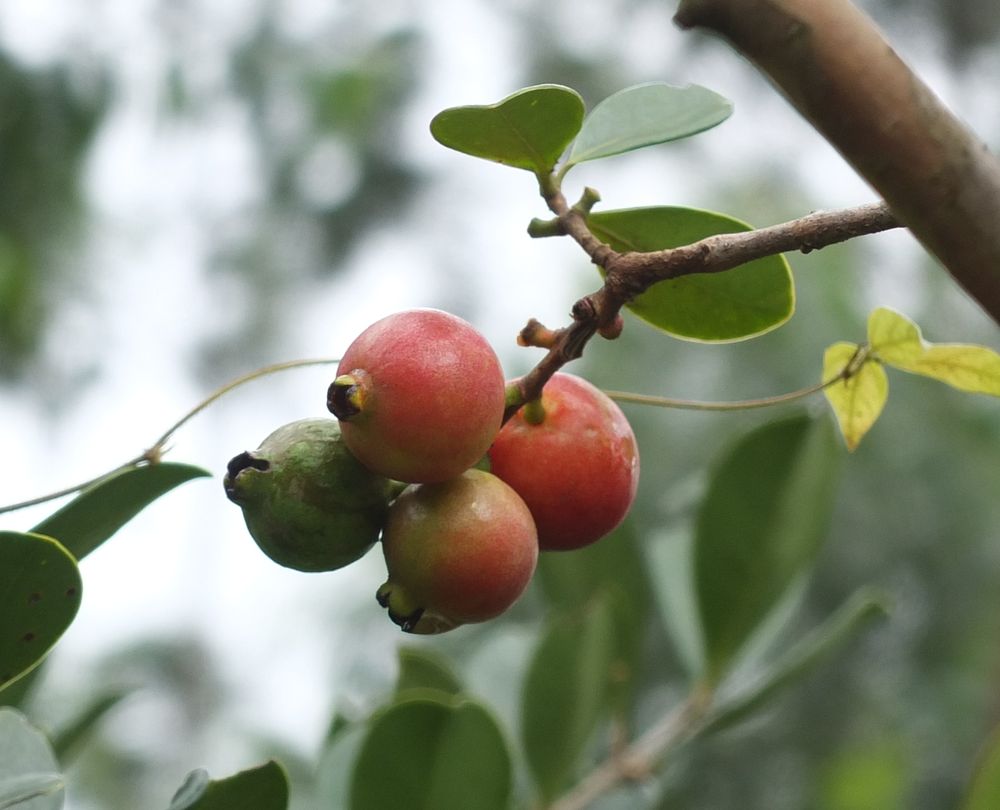
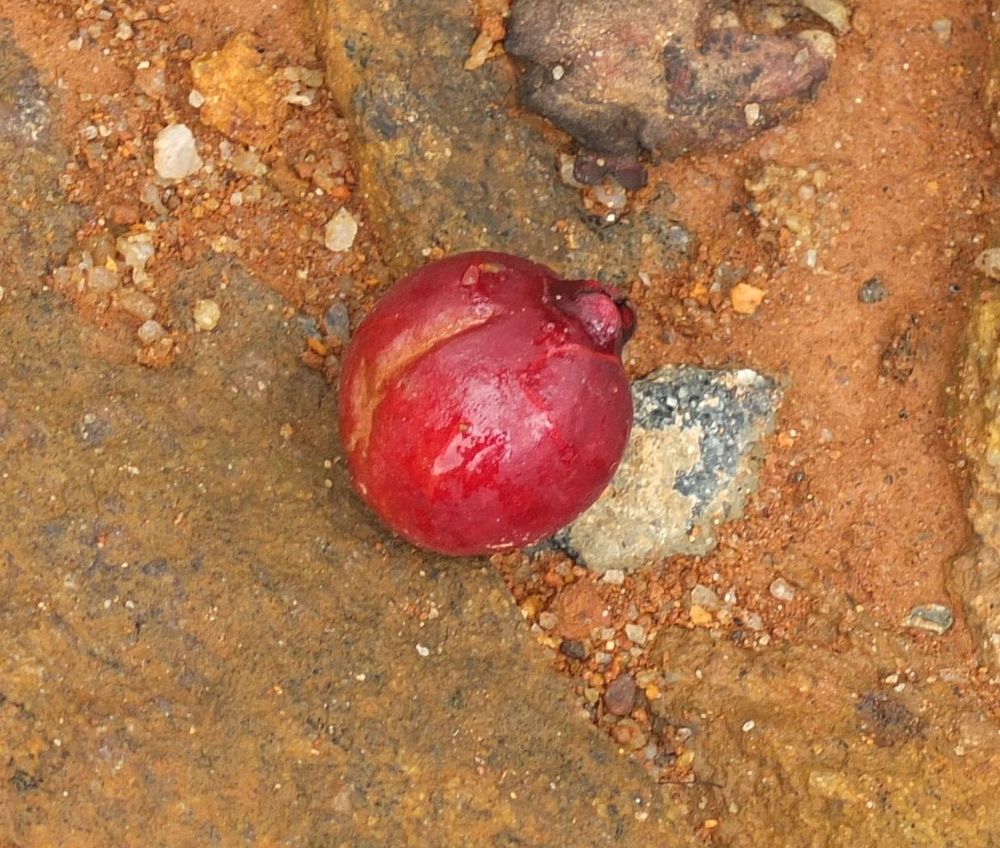
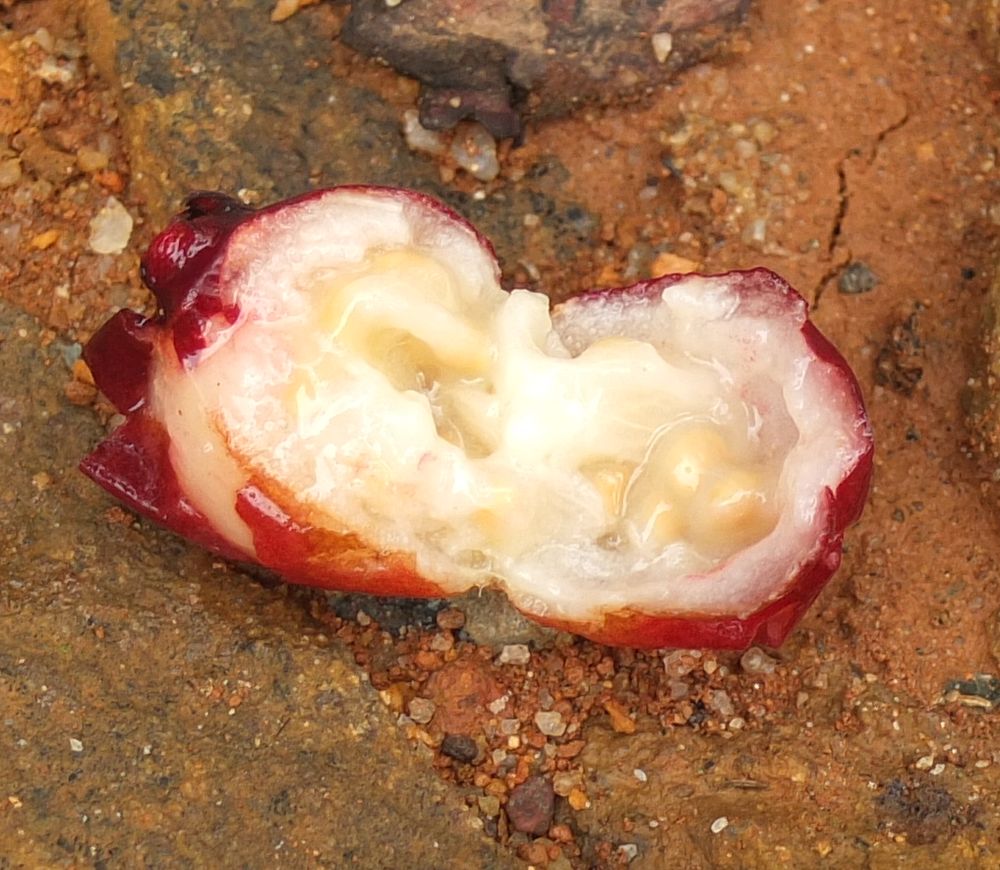
In Laos, we are familiar with Guava trees (ton mak sida) that grow easily in gardens, on roadsides, in fields and whose fruits are commonly sold in markets. But what is called Strawberry Guava the is much rarer.
Like the Guava tree, Psidium guajava, the Strawberry Guava, Psidium cattleianum is a shrub or small tree with smooth brown bark. Its leaves are very different from those of the Guava tree, they are oval, smooth, thick, dark green, with barely visible veins. The flowers resemble those of the ton mak sida, they are white with a tuft of yellow stamens in the center. The fruit also immediately evokes the Guava, it is however smaller, still marked by the calyx scar but it is especially its purplish red color when ripe that makes the difference; its skin is smooth, shiny and cracks under the tooth. It contains a white pulp that envelops a few yellow seeds. This Strawberry Guava, unlike the Guava, can be eaten whole; it is juicy, refreshing, slightly acidic and the few seeds are not bothersome to swallow; its taste is sometimes described as that of wild Strawberry, sometimes as that of Passion fruit with an additional note of Rose petal!
We then understand the names that have been given to it in reference to other fruits from temperate countries. The genus Psidium is native to Latin America and more particularly to Brazil for P. cattleianum. The scientific name “psidium” comes from the Greek “psidion” which names the Pomegranate (mak phila) and the attribute “cattleianum” honors the English horticulturist William Cattley.
For its fruit, which is used to make juices, jams and wines, the Strawberry Guava tree has been introduced and has become naturalised in many tropical areas, particularly the Indian Ocean, Sri Lanka, Reunion Island and the Pacific Islands. Thailand and Vietnam have also undertaken planting trials. However, these introductions are not without risk, particularly in islands with fragile ecosystems. The Strawberry Guava tree, which is even more hardy than the Guava tree, reproduces quickly and well; it quickly forms dense thickets that gradually exclude the original vegetation. It is considered one of the most invasive species in several islands of the Indian Ocean (Mauritius and Reunion Island), Australia and Hawaii.
On connaît bien au Laos les goyaviers (ton mak sida) qui poussent facilement dans les jardins, sur les bords de route, dans les champs et dont les fruits sont couramment vendus sur les marchés. Mais ce que l’on nomme, à tort, la goyave de Chine est beaucoup plus rare.
Comme le goyavier, Psidium guajava, le goyavier de Chine, Psidium cattleianum est un arbuste ou un petit arbre à l’écorce brune et lisse. Ses feuilles sont très différentes de celles du goyavier, elles sont ovales, lisses, épaisses, vert sombre, avec des nervures à peine visibles. Les fleurs ressemblent à celles de ton mak sida, elles sont blanches avec au centre une houppette d’étamines jaunes. Le fruit lui aussi évoque tout de suite la goyave, il est cependant plus petit, toujours marqué par la cicatrice du calice mais c’est surtout sa couleur rouge violacé à maturité qui fait la différence; sa peau est lisse, brillante et craque sous la dent. Il contient une pulpe blanche qui enveloppe quelques graines jaunes. Cette goyave–fraise, à la différence de la goyave, peut être croquée toute entière; elle est juteuse, rafraîchissante, légèrement acidulée et les quelques graines ne sont pas gênantes à avaler; son goût est décrit tantôt comme celui de la fraise des bois, tantôt comme celui du fruit de la passion avec en outre une note de pétale de rose !
On comprend alors les noms qui lui ont été donnés en référence à d’autres fruits de pays tempérés. En revanche l’appellation goyave de Chine est impropre puisque le genre Psidium est originaire d’Amérique latine et plus particulièrement du Brésil pour P. cattleianum. Le nom scientifique « psidium » vient du grec « psidion » qui nomme la grenade (mak phila) et l’attribut « cattleianum » honore l’horticulteur anglais William Cattley.
Pour son fruit avec lequel on fait des jus, des confitures et des vins, le goyavier de Chine a été introduit et s’est naturalisé dans de nombreuses zones tropicales en particulier l’Océan indien, le Sri Lanka, la Réunion, les îles du Pacifique. La Thaïlande et le Vietnam ont entrepris eux aussi des essais de plantation. Mais ces introductions ne sont pas sans risque, en particulier dans les îles à l’écosystème fragile. Le goyavier de Chine plus rustique encore que le goyavier se reproduit vite et bien; il forme rapidement des fourrés denses qui excluent peu à peu la végétation d’origine. Il est considéré comme l’une des espèces les plus invasives dans plusieurs îles de l’Océan Indien (Maurice et la Réunion), en Australie et à Hawaï.










In Laos, we are familiar with Guava trees (ton mak sida) that grow easily in gardens, on roadsides, in fields and whose fruits are commonly sold in markets. But what is called Strawberry Guava the is much rarer.
Like the Guava tree, Psidium guajava, the Strawberry Guava, Psidium cattleianum is a shrub or small tree with smooth brown bark. Its leaves are very different from those of the Guava tree, they are oval, smooth, thick, dark green, with barely visible veins. The flowers resemble those of the ton mak sida, they are white with a tuft of yellow stamens in the center. The fruit also immediately evokes the Guava, it is however smaller, still marked by the calyx scar but it is especially its purplish red color when ripe that makes the difference; its skin is smooth, shiny and cracks under the tooth. It contains a white pulp that envelops a few yellow seeds. This Strawberry Guava, unlike the Guava, can be eaten whole; it is juicy, refreshing, slightly acidic and the few seeds are not bothersome to swallow; its taste is sometimes described as that of wild Strawberry, sometimes as that of Passion fruit with an additional note of Rose petal!
We then understand the names that have been given to it in reference to other fruits from temperate countries. The genus Psidium is native to Latin America and more particularly to Brazil for P. cattleianum. The scientific name “psidium” comes from the Greek “psidion” which names the Pomegranate (mak phila) and the attribute “cattleianum” honors the English horticulturist William Cattley.
For its fruit, which is used to make juices, jams and wines, the Strawberry Guava tree has been introduced and has become naturalised in many tropical areas, particularly the Indian Ocean, Sri Lanka, Reunion Island and the Pacific Islands. Thailand and Vietnam have also undertaken planting trials. However, these introductions are not without risk, particularly in islands with fragile ecosystems. The Strawberry Guava tree, which is even more hardy than the Guava tree, reproduces quickly and well; it quickly forms dense thickets that gradually exclude the original vegetation. It is considered one of the most invasive species in several islands of the Indian Ocean (Mauritius and Reunion Island), Australia and Hawaii.
On connaît bien au Laos les goyaviers (ton mak sida) qui poussent facilement dans les jardins, sur les bords de route, dans les champs et dont les fruits sont couramment vendus sur les marchés. Mais ce que l’on nomme, à tort, la goyave de Chine est beaucoup plus rare.
Comme le goyavier, Psidium guajava, le goyavier de Chine, Psidium cattleianum est un arbuste ou un petit arbre à l’écorce brune et lisse. Ses feuilles sont très différentes de celles du goyavier, elles sont ovales, lisses, épaisses, vert sombre, avec des nervures à peine visibles. Les fleurs ressemblent à celles de ton mak sida, elles sont blanches avec au centre une houppette d’étamines jaunes. Le fruit lui aussi évoque tout de suite la goyave, il est cependant plus petit, toujours marqué par la cicatrice du calice mais c’est surtout sa couleur rouge violacé à maturité qui fait la différence; sa peau est lisse, brillante et craque sous la dent. Il contient une pulpe blanche qui enveloppe quelques graines jaunes. Cette goyave–fraise, à la différence de la goyave, peut être croquée toute entière; elle est juteuse, rafraîchissante, légèrement acidulée et les quelques graines ne sont pas gênantes à avaler; son goût est décrit tantôt comme celui de la fraise des bois, tantôt comme celui du fruit de la passion avec en outre une note de pétale de rose !
On comprend alors les noms qui lui ont été donnés en référence à d’autres fruits de pays tempérés. En revanche l’appellation goyave de Chine est impropre puisque le genre Psidium est originaire d’Amérique latine et plus particulièrement du Brésil pour P. cattleianum. Le nom scientifique « psidium » vient du grec « psidion » qui nomme la grenade (mak phila) et l’attribut « cattleianum » honore l’horticulteur anglais William Cattley.
Pour son fruit avec lequel on fait des jus, des confitures et des vins, le goyavier de Chine a été introduit et s’est naturalisé dans de nombreuses zones tropicales en particulier l’Océan indien, le Sri Lanka, la Réunion, les îles du Pacifique. La Thaïlande et le Vietnam ont entrepris eux aussi des essais de plantation. Mais ces introductions ne sont pas sans risque, en particulier dans les îles à l’écosystème fragile. Le goyavier de Chine plus rustique encore que le goyavier se reproduit vite et bien; il forme rapidement des fourrés denses qui excluent peu à peu la végétation d’origine. Il est considéré comme l’une des espèces les plus invasives dans plusieurs îles de l’Océan Indien (Maurice et la Réunion), en Australie et à Hawaï.


